Introduction to Python Programming
- 2. Google (Youtube) Facebook (Tornado) Dropbox Yahoo NASA IBM Mozilla Quora Instagram (Django) Reddit
- 3. Search algorithms Log analysis Google Data Python Client Library Google APIs Client Library for Python Google AdWords API Python Client Library Machine Learning Robotics projects
- 5. NAME IS BASED ON A BBC COMEDY SERIES FROM THE 1970S Monty Python's Flying Circus Guido van Ro s s u m December 1989
- 6. Python is used across domains such as: Scripting Testing Web Development IoT Programming Data Science
- 7. Programming is error-prone! Programming errors are called bugs The process of tracking them down is called debugging
- 8. Easy-to-learn: Python has few keywords, a simple structure, and a clearly defined syntax. Easy-to-read: Python code is more clearly defined and visible to the eyes. Easy-to-maintain: Python's source code is fairly easy to maintain. A broad standard library: Python's bulk of the library is very portable and cross-platform compatible on UNIX, Windows, and Macintosh. Interactive Mode: Python has support for an interactive mode that allows interactive testing and debugging of snippets of code. Portable: Python can run on a wide variety of hardware platforms and has the same interface on all platforms.
- 9. Extendable: You can add low-level modules to the Python interpreter. These modules enable programmers to add to or customize their tools to be more efficient. Databases: Python provides interfaces to all major commercial databases. GUI Programming: Python supports GUI applications that can be created and ported to many system calls, libraries, and windows systems, such as Windows MFC, Macintosh, and the X Window system of Unix. Scalable: Python provides a better structure and support for large programs than shell scripting.
- 10. Portability: A property of a program that can run on more than one kind of computer. Interpret: To execute a program in a high-level language by translating it one line at a time. Compile: To translate a program written in a high-level language into a low-level language all at once, in preparation for later execution.
- 13. A program is a sequence of instructions that specifies how to perform a computation. Input: Get data from the keyboard, a file, or some other device. Output: Display data on the screen or send data to a file or other device. Process: 1.Math: Perform basic mathematical operations like addition and multiplication. 2.Conditional execution: Check for certain conditions andexecute the appropriate code. 3.Repetition: Perform some action repeatedly, usually with some variation.
- 17. Num bers 1.int (signed integers): They are often called just integers or int, are positive or negative whole numbers with no decimal point. 2. long (long integers ): Also called long, they are integers of unlimited size, written like integers and followed by an uppercase or lowercaseL. 3. float (floating point real values): Also called floats, they represent real numbers and are written with a decimal point dividing the integer and fractional parts. Floats may also be in scientific notation, with Eor e indicating the power of 10 (2.5e2 = 2.5 x 102= 250). 4. complex (complex numbers): Are of the form a + bJ, where a and b are floats and J (or j) represents the square root of -1 (which is an imaginary number). The real part of the number is a, and the imaginary part is b.
- 18. 1.Variables are reserved memory locations that are used to store values and are referenced by a name. Example: Assigning a contact number and referencing it by a contact name 2.Syntax to define a variable is asfollows: variableName = value Example: phoneNumber = 12345
- 19. Variable name should start with an alphabet orunderscore (‘_’) followed by any number of alphabets, digits andunderscores Variable names are case sensitive. Example: phoneNumber is different from PhoneNumber and phonenumber Variable name cannot be a reserved name Example: print, if, for, etc Variable name cannot contain any special character other thanunderscore
- 21. List , List comprehension Tuple Dictionary
- 22. Syntax error Semantic Error Runtime Error
- 23. While loop – syntax-while(condition): For loop – syntax – for i in range(0,n):
- 24. A collection of built-in modules, each providing different functionality beyond what is included in the corePython. import math math.sqrt(16) math.factorial(10) These are called as fruitful functions in python.
- 25. Functions are created to make calculations easy toreuse The general form of a function call is <<function_name>>(<<arguments>>) An argument is an expression that appears between the parenthesis of a function call. The number within parenthesis in the below function call is argument.
- 27. Rules to execute a function call: Evaluate each argument one at a time, working from left to right. Pass the resulting values into the function. Executes the function. The result is obtained. abs(-7) + abs (3) pow(abs(-2), round(3.2))
- 28. X = input(“Enter an expression:”) Multiple assignments are also possible Ex: x,y = 3,4 x,y = map(int, input().split())
- 29. def f1(): •print(‘Inside the function’) f1()
- 31. def add(): print(“Enter 2 numbers to add:”) a =int(input(“1st number:”)) b =int(input(“2nd number:”)) return(a+b) result = add() print(‘After addition:’ result)
- 32. num=int(input("Enter the number")) fact=1 for i in range (1,num+1): fact=fact*i print(fact)
- 33. def fact(num): fact=1 for i in range (1,num+1): fact=fact*i print(fact) return fact num=int(input("Enter the number")) fact(num)
- 34. def fact(num): if(num==1): return(1 ) else: return num*fact(num-1) num=int(input("Enter the number")) print(fact(num))
- 35. Strings are a collection of characters. They are enclosed in single or double-quotes. Eg: ‘Climate is pleasant’ ‘1234’ ‘#@$’
- 36. Operators overloading are available in default. 3*’a’ = ‘aaa’ ‘a’+’a’ = ‘aa’ ‘a’ +3 will give synatax error (you cannot add a string anda number) ‘a’ +‘3’ = ‘a3’ ‘a’*’a’ will give a syntax error.
- 37. Indexing is used to extract individual characters from astring Indexing in python starts from 0. S =‘welcome’ S[0] = ‘w’ S[1]=‘e’ ….
- 38. Slicing is taking subsets from a string. Lower limit is inclusive where as Upper limit isexclusive. S=‘welcome’ S[0:2] ?? S[0:] ?? S[:3] ?? S[:] ??? S[0:4]??
- 39. ‘a’ in ‘ssn’ ‘ss’ in ‘ssn’ Replacing a string: Text =‘Python is easy’ Text =Text.replace(‘easy’ , ‘easy and powerful’)
- 40. Explore the other functions -Assignment
- 41. Write a python function to find the max of 3 numbers Check whether a number is palindrome using function Check whether a string is palindrome using function
- 42. Write a Python function that accepts a string and calculatethe number of upper case letters and lower case letters








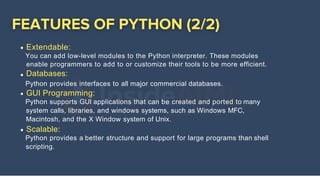


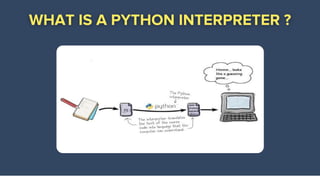















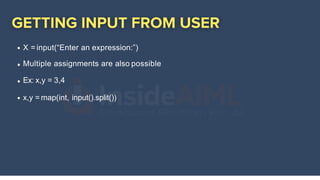


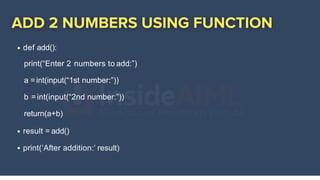



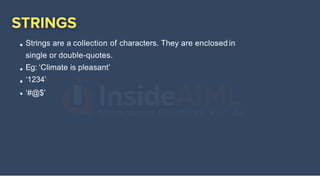
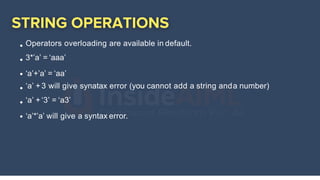
![Indexing is used to extract individual characters from astring
Indexing in python starts from 0.
S =‘welcome’
S[0] = ‘w’
S[1]=‘e’ ….](https://image.slidesharecdn.com/introductiontopythonprogramming-210518114757/85/Introduction-to-Python-Programming-37-320.jpg)
![Slicing is taking subsets from a string.
Lower limit is inclusive where as Upper limit isexclusive.
S=‘welcome’
S[0:2] ??
S[0:] ??
S[:3] ??
S[:] ???
S[0:4]??](https://image.slidesharecdn.com/introductiontopythonprogramming-210518114757/85/Introduction-to-Python-Programming-38-320.jpg)



